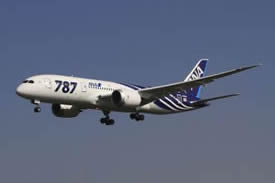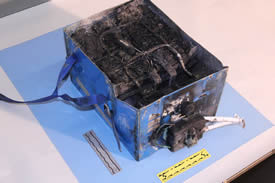| BlueSky Business Aviation News | |||||||||||||||||||||||
|
|||||||||||||||||||||||
While the chances of a fire caused by a lithium battery are very small, fire in the aircraft in general is one of a crewmember’s worst fears. The seemingly specialized nature of a lithium battery fire makes pilots and flight attendants even uneasier, and with good reason. I wanted to take the opportunity to explain a little about Lithium battery fires and what we teach at Aircare FACTS as part of our emergency procedures training for business aviation pilots and flight attendants.
The battery pack also contains other components such as a temperature sensor, a voltage regulator and even a tiny computer that monitors the charge state. These components draw power from the pack even when the device is shut down. 'Thermal Runway' The cool thing about LIBs, pun intended, is that they are very small, lightweight and pack a tremendous amount of power in them as compared to those heavy batteries that you use in your flashlight or the TV remote. The not so cool thing about LIBs is that they are much more reactive and volatile than traditional “dry cell” batteries. When exposed to excessive heat or when overcharged they can enter a state called ‘thermal runaway’ and then bad things happen. I like to think of thermal runaway as my goofy dog chasing his tail. He’s lying there quietly and then some defect, in his case a severe mental short circuit, causes him to notice his tail. This excites him and his tail wags a little more causing him to take even more of an interest. He gets more excited and this causes his body to move and he lunges with his head. The more he moves the faster he chases until he’s running around in circles in an idiotic blur.
Normal, properly manufactured LIBs don’t go into thermal runaway and they have several safeguards in the cell design and in the battery pack that are supposed to prevent this. Thermal runaway in an LIB occurs when a defect in the battery, for example a tiny piece of metal inside the cell that was left during manufacturing, suddenly connects or short circuits the positive and negative electrodes internally. This causes the cell to discharge irregularly and overheat. As it overheats the chemical reaction increases and consequently so does the overheating. It gets to a point where it’s out of control. This can occur during charging, using or even storing the device. When the temperature of the cell gets to a certain point the pressure causes the cell to essentially explode causing even higher temperature when the electrolyte ignites (around 1700º F or 927º C). Meanwhile the cell has gotten so hot that it has caused the adjacent cell to also go haywire, and it may also enter a state of thermal runaway. It keeps going this way until all of the cells in the battery have exploded. This may take fifteen minutes or less for all the cells to go off. Cells erupt violently. When they go they usually take part of the cell casing with it, as well as the battery housing, and the device chassis with it. There is also usually a large flame caused by burning electrolyte that is incredibly hot. It’s not good. The FAA has done some pretty extensive research on this subject as well as techniques to battle an LIB fire on the aircraft. The results and recommendations can be found on FAA SAFO 09013. At Aircare FACTS Training we teach these procedures combined with additional techniques to business aviation crews. We also developed a product called the Aircare FireSock to help with LIB fires on the plane. If you see a smoking laptop on the table, be glad One thing that I tell pilots and flight attendants when they call us is that if you are at FL 35 and you see a smoking laptop on the table, be glad. Well, wait until you are safely on the ground, but when you finally are, be glad that the laptop, phone or tablet wasn’t in the cargo hold and that you didn’t discover the fire because a warning went off on the flight deck. A smoking laptop on the table is a best-case scenario because it’s right there, you can see it happening, you know what’s causing it and you can do something about it immediately. Your mission in life at this point is to protect yourself, your passengers and to stop thermal runaway from proceeding. Stopping thermal runaway immediately will stop all other bad things that go along with it from happening such as smoke, secondary fire or in a worst case scenario a class D fire. A class D fire is when metals such as magnesium or titanium get hot enough to ignite. Once this happens there is very little that can be done to stop it and there is no fire fighting equipment on board that can put out a class D fire. Because of it’s light weight, many of today’s laptops are made from magnesium alloys. The older Apple Titanium models were actually made out of titanium. Recommended procedures for Lithium Battery fires in aircraft Here is what we recommend for procedures for Lithium Battery fires in aircraft:
This incident is automatically causing a series of things to happen including fire fighting, smoke removal procedures, flight diversion, preparation for emergency landing, and coordinating a planned evacuation. The last thing you want or need is to add a medical emergency to this list or to have a pilot or flight attendant incapacitated. Keep yourself in the game. Move passengers to a safe location. If you have supplemental smoke hoods tell them where they are and have them put them on.
This is the point where the FireSock is employed but I’m not going to get into that here.
If you’re not already, we also recommend that you become more conscious of where laptops and devices are being stowed. This is especially true if you are deadheading and your laptop is sitting in the cabin. You may decide to change standard operating procedures so that devices are no longer carried in the hold. A lithium battery fire on an aircraft is not nearly as fun to watch or as concerning as my dog chasing its tail. But a good understanding of what is happening and the fundamentals of how to make it stop may be your second best friend.
Aircare Solutions Group, headquartered in Olympia WA., is comprised of business aviation companies that combined, provide Crewmember Emergency Procedures Training, Tele-medical Assistance, and Quality Crew Staffing to flight departments worldwide:
|
|||||||||||||||||||||||


